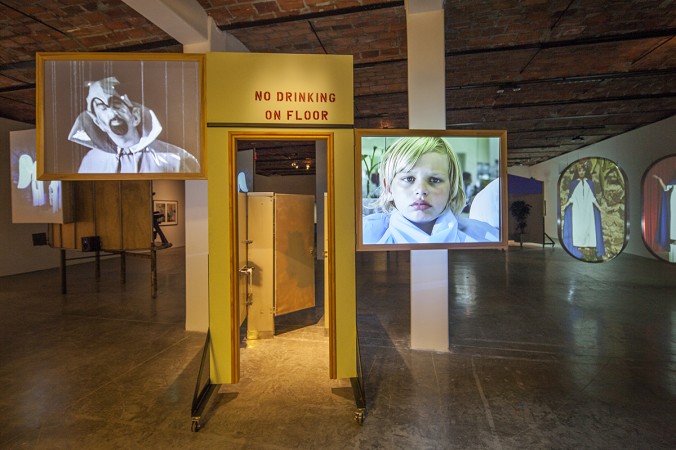Mike Kelley at MoMA PS1

Mike Kelley. Day is Done. 2005-06. Installation view in Mike Kelley at MoMA PS1, 2013. © 2013 MoMA PS1; Photo Matthew Septimus.
On view through February 2 at MoMA PS1 in Long Island City, Queens, Mike Kelley is an exhaustive retrospective with a deceivingly simple title. The exhibition, which pulls over 200 works from the late artist’s archive, manages to occupy just about every available space in the museum, showcasing the artist’s tendency to continually experiment with new types of media and thematic content throughout his celebrated career. The show is a milestone for both PS1 and Kelley for a number of reasons: not only is it the first chance for American audiences to see the artist’s first major museum exhibition since his tragic suicide in 2012 (the show toured to PS1 from an initial run at the Stedelijk Museum in Amsterdam and then the Centre Pompidou in Paris, and will open again at the Museum of Contemporary Art, Los Angeles in March), it is also the museum’s largest solo exhibition in its 42 year history.
The massive variety of works on display is enough to satiate both unfamiliar visitors as well as longtime fans of the artist’s work. Kelley’s collaborative efforts with Sonic Youth, such as his 1986 audio piece, Plato’s Cave, Rothko’s Chapel, Lincoln’s Profile and the 1991 photographic work Ahh … Youth! (used as the artwork for Sonic Youth’s Dirty) are some of the artist’s most casually recognizable efforts. Similarly, his video collaborations with Paul McCarthy will likely secure additional nods of approval from attendants of McCarthy’s recent Park Avenue Armory blockbuster, WS. The exhibition’s first floor galleries are also home to Kelley’s Kandor series of sculptural works exploring Superman’s fictitious home city, which was featured in a 2008 issue of Interview Magazine.
While Kelley’s high-profile joint efforts are certainly notable points in the show, the most compelling aspects of the exhibition come in the form of immersive installation pieces that showcase the extensive magnitude of the artist’s body of work. Day is Done, originally shown at Gagosian Gallery in 2005, is an overwhelming and hypnotic combination of video projections, sculpture, and photography that creates a staggering cacophony of noise and images. Pay For Your Pleasure, which was originally shown at Chicago’s Renaissance Society in 1988, consists of a long corridor covered floor-to-ceiling in brightly saturated paintings of noted twentieth-century artists and thinkers, adorned with quotes reflecting on madness, criminality, and creativity. The piece is accompanied by a painting by a local criminal and two donation boxes for victim’s rights organizations. Originally conceived in response to the crimes and subsequent celebrity status of John Wayne Gacy, the installation is simultaneously unnerving and eloquently poignant. Rose Hobart II consists of a large-scale wooden sculpture with a small tunnel into which visitors, one at a time, are allowed to crawl. The corridor is disconcertingly dark and claustrophobic, and it ends after a short incline to reveal a peephole through which viewers can voyeuristically watch a looping video.

Mike Kelley. Deodorized Central Mass with Satellites. 1991/1999. Plush toys sewn over wood and wire frames with styrofoam packing material, nylon rope, pulleys, steel hardware and hanging plates, fiberglass, car paint, and disinfectant. Overall dimensions variable. (c) Estate of Mike Kelley. Images courtesy of Perry Rubenstein Gallery, Los Angeles. Photography: Joshua White/JWPictures.com.
Mike Kelley is rounded out by showcasing the vast extent to which the artist was willing to experiment with both medium and subject. Series of paintings, photography, sculpture, film, video and performative pieces illustrate a constant yearning for experimentation and reinvention. Kelley’s work shifts between explorations of sexuality, abuse, pop culture, memory, madness, and the art world. Kelley himself frequently appears in his work, and this exhibition works well to expose the degree to which the artist grew both physically and aesthetically up to the tragically abrupt end of his career.
Holland Cotter’s New York Times review of Mike Kelley exclaimed that it “knocks everything else in New York this fall right out of the ring,” underscoring both the exhibition’s cultural significance as well its ability to solicit physical reactions from its viewers. While east coast visitors only have a few remaining days to visit the show before its departure from PS1 on February 2, its subsequent run at the Museum of Contemporary Art, Los Angeles will last from March 31 until July 28. The exhibition will be installed at MOCA’s Geffen Contemporary Building in LA’s Little Tokyo, and, as with PS1, the show will occupy the entirety of the space.
Although Kelley is now gone, his legacy will doubtlessly reverberate for countless generations of new artists, and his retrospective is essential viewing for 2014.





















